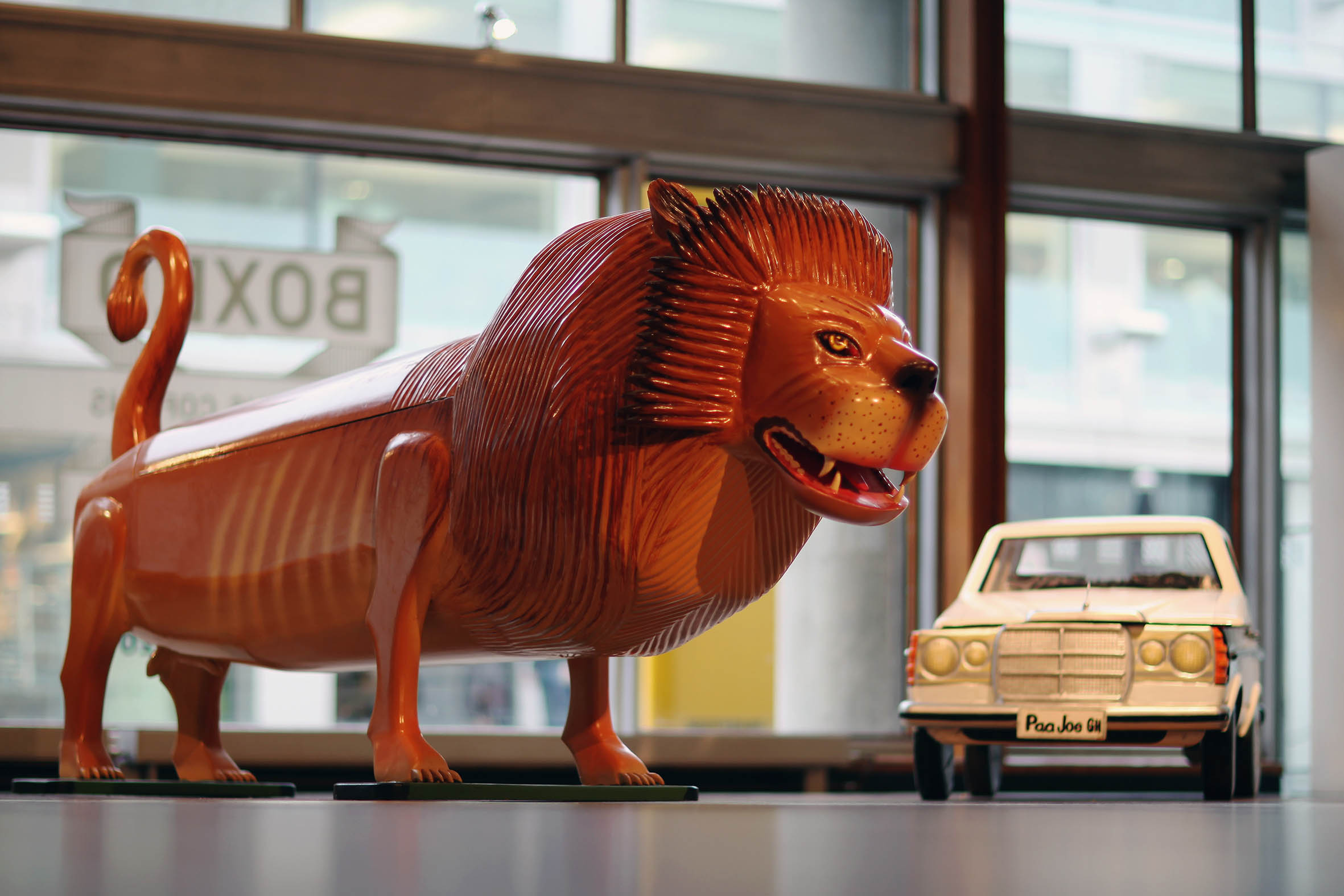A 2012 exhibition in London featured a collection of coffins some made at the famous Paa Joe Coffin Works in Ghana. The Ga people use coffins to make statements about identity, ancestral power and status. Photo: Dan Kitwood/Getty Images
A pink fish, a fierce lion, an NBA basketball or even an octopus. These are all potential shapes for the figurative “fantasy” coffins made and used by the Ga people of Ghana.
Western academics, museums, collectors and popular media have become intrigued by the cultural practice and the colourful coffins as the artists who create them have increasingly become more widely known. A quick scan of recent articles reveals a fascination with the way these coffins and artists “put the fun in a funeral”, “celebrate death in style” and “spruce up the pine box”.
The words “fantasy coffin” conjure up images of unrestrained imagination, fantastic, almost unbelievable shapes, and the stuff of personal dreams. But the word “fantasy” did not originate with the Ga.
They refer to the coffins as abebuu adekai, which can be roughly translated as “receptacles of proverbs” or “proverbial coffins”. Put simply, the coffins are imbued with meaning. The practice arose from changing colonial and postcolonial attitudes towards the dead and make very public statements about familial identity, ancestral power and status in increasingly competitive environments. The cultural significance of their use has been documented in both popular media and scholarship.

Figurative send-off: In Ghana, coffins are treated less playfully than the overly simplistic interpretation foreign cultures tend to give them. Some of these imaginative coffins were never intended even to be buried
So, to label the coffins and associated practices as fantasy is not only simplistic but also misleading. They are, in fact, highly emotional and complex.
But this is not to deny the imagination, creativity and personalisation that goes into making them. I discovered this for myself when I visited the Paa Joe Coffin Works in Ghana in 2017 to conduct preliminary research for an exhibition of the coffins at the Mathers Museum of World Cultures at Indiana University. There I met Paa Joe, one of the most widely known and respected figurative coffin artists, and the artisans he collaborates with. I witnessed and learned not only about the contemporary processes involved in making these coffins but also about their significance in an increasingly globalised marketplace.
The creation of these coffins begins with the artists and the
people who commission them. Once a shape has been decided upon, either by the deceased’s family, the artists themselves, or a collector, the artists begin their work. Imagination is essential as the coffin makers consider how to make the elaborate forms materialise with just wooden planks, nails, putty and paint.
The artists of the Paa Joe Coffin Works work primarily from photographs and rarely sketch out their designs. They rely on their intimate knowledge of their materials, technical skill and many years of apprenticing.
Although some forms, such as fish, are more common and frequently made for both local use and Western collectors, other more elaborate shapes require careful consideration. Paa Joe says designs such as the large chameleon that was in his showroom at the time can keep him up at night thinking.
These increasingly elaborate forms are most often created for collectors and exhibition rather than for burial.
While I was at the workshop, the staff were working on a variety of projects including an ear of corn coffin for a farmer’s burial, lion palanquins for local chiefs, and sea-themed coffins for an exhibition in Accra. The exhibition commissions are never intended for burial and give the
artists the opportunity to show off their skill to wider audiences.
Regardless of the academic temptation to focus only on the “authentic” coffins for burials, those commissioned for collectors and museums, along with overseas artist residencies, now comprise a large part of the income and artistic practices of workshops such as the Paa Joe Coffin Works. In fact, Paa Joe and his collaborators consider themselves as artists.
In the documentary, Paa Joe and the Lion (2016), he says: “I can create an image of you out of wood so good that you will greet it in the morning. So, yes, I see myself as an artist.”
He and his colleagues are not only continuing the tradition of abebuu adekai but also popularising the coffins globally.
This article was originally published in Africasacountry.com